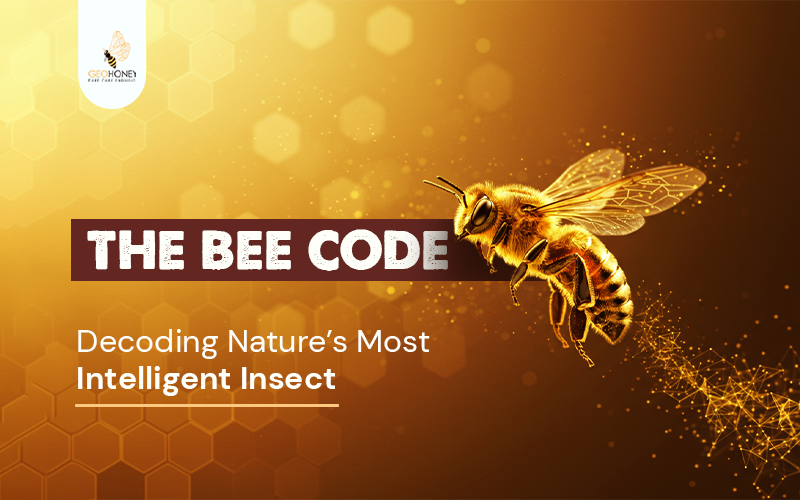- Tokyo: 20:27
- Singapore: 19:27
- Dubai: 15:27
- London: 11:27
- New York: 06:27
The Bee Code: Decoding Nature’s Most Intelligent Insect

Bees possess a superior intelligence than most insects or pollinators, and it is evident from their living and foraging habits. A bee’s brain is no bigger than a sesame seed, but still, they are able to learn and adapt to their surroundings quite effectively.
Some researchers suggest this high intelligence of bees stems from their high brain density, which is about 10 times greater than that of most mammals.
According to the founder of Geohoney and the CEO of B A Barry Group, Mr Basem Barry
“Honey bees are social creatures who possess exceptional individual and collective intelligence. They possess the ability to remember colors, locations, and types of flowers, which drives their behaviours and decision-making.”
This blog uncovers the secrets of the intelligence of the honey bees. This information will help you decode what makes these creatures so smart so, keep on reading till the end.
The Brain of a Honey Bee
How Do We Know Bees are Smart?
Bees Think and Make Collective Decisions
Bees Can Count and Solve Puzzles
Emotional Intelligence
Bees Recognize Human Faces
Bees Communicate Through Dance
Communication Via Pheromones
The Brain of a Honey Bee
The brain of a honey bee measures just about one cubic millimetre. But this doesn’t limit the cognitive abilities of these hardworking creatures. The greater brain density of these bees and the larger number of neurons than most mammals compensate for this small size.
They possess a very sophisticated sensory system, which gives them a superior sight, a keen sense of smell, and impressive tasting and touching abilities. The brains of honey bees are neuroplastic.
This means they can learn new information and adapt to their surroundings quite well. It also shows that they can store memory in more than one location in the brain.
How Do We Know Bees Are Smart?
But how do we know that bees are smart or they possess intelligence? There are many things that support this claim. Observations have shown that bees possess the ability to think and learn new things. Bees can differentiate between colors, flowers, landscapes, and patterns to create the purest monofloral organic honey.
Bees can remember route details of up to 6 miles. They conceptualize the maps and determine the shortest routes to their final destinations.
Bees perform different roles in their lifetimes, which require them to learn and master demanding skills. Bees nurse the brood, make honeycombs, forage nectar, and convert it to honey, which is a testament to their impressive intelligence.
These creatures are expert planners and decision-makers. Bees can also count numbers and sense time, which allows them to regulate their tasks. The forager bees identify flowers, assess their conditions, and communicate this information to the hive in the most accurate fashion.
Bees are also capable of cultural transmission. Several experiments have been conducted where one bee was taught to pull a string to get a reward. Other bees learned to do that by simply observing the first bee. This means the technique was communicated to the bees, which shows there is a certain sending and receiving of information between them.
Following are some specific facts about bees that show why they are nature’s most intelligent insects.
Bees Think and Make Collective Decisions
There are many tasks that a honey bee has to perform both inside and outside the hive during its lifetime, and most of these tasks require a certain level of intelligence and thinking.
Bees find flowers, collect the nectar, make their way back to the hive, create raw honey, and give the pertinent information to the colony.
Bees also make collective decisions and pay special attention to only spreading accurate information. When bees find that the information provided by another bee clashes with their own personal experience, they do not pass it on to the other members of the colony.
When looking for a new home, bees form a small colony of about 200 older bees who go out and find a suitable new location for thousands of bees back in the hive, which is another feat that requires great intelligence.
When choosing a nectar source, a bee will land on the source and assess whether it is good or not. If it is good, it will do a special waggle dance to call other bees to that source.
If the source is poor, the bee will not do any dance. Instead, it will look for other bees who do that dance and move to that source. This collective decision-making ensures optimal collection of good-quality nectar.
Bees Can Count and Solve Puzzles
Research on bees has shown that bees can discriminate between and compare different numbers and quantities. They can identify, for example, a paper with zero dots and differentiate it from a paper with a few dots.
This shows the bees intrinsically have a sense of the number zero or the empty set, which is a feat only humans can do. Research from the Queen Mary Institute in London in 2017 demonstrated that bees could learn to do normal tasks and puzzles to gain a reward.
One bee was taught to move a small ball from point A to point B to get a sweet treat. This bee relayed this information to other bees, who not only learned the task but also did it more efficiently.
Emotional Intelligence
Bees can understand and even embody certain emotions. Researchers studied the behaviour of a group of bees before and after shaking them in a chemical mixing device. After that, they looked at how these bees approached appealing and unappealing chemical smells.
The shaken bees approached even the good-smelling chemicals hesitantly, as it triggered a similar response to when they were shaken inside the device. This shows that certain situations trigger emotional responses in honey bee,s which is another sign of intelligence.
Bees Recognize Human Faces
Another remarkable sign of the intelligence of honey bees is the ability to remember human faces. There is also interesting research to support this claim.
A scientist named Dr Adrian Dyer at Cambridge University, England pinned photographs of four different people onto a board. He then coaxed the bees to land on a target face and rewarded them with a sucrose solution if they did it right.
He was impressed to see that bees were able to land on the target face about 90% of the time, even after varying its location or in the absence of any reward. Even more surprising was the fact that bees remembered the face of the target even two days after the initial interaction.
Bees Communicate Through Dance
Honey bees use several types of dances to communicate with other bees. Their ability to pick and choose special dances to convey certain essential information also shows they are highly intelligent creatures.
The following are some common forms of the amazing dance language of honey bees
The Round Dance
In this case, the bees dance around in a circle to show that the nectar source is very close. This shows those bees that they can just go out and use their sense of smell to locate food or nectar.
The Waggle Dance
This dance is used to guide the bees towards the nectar source that is a little farther away. The bees walk in a straight line relative to the sun in the direction of the source.
The bee then performs this dance in a specific angle which shows the location of the food source. As the bee waggles her body, other bees immediately know the direction of the nectar source. The number of waggles shows how far away that source is.
A line of bees connects the hive and the food source, while another line connects the hive to the spot on the horizon just beneath the sun. The angle between these two lines shows the location of the food or nectar source.
Dancer bees also take the movement of the sun into account. They change the angle every 4 minutes by one degree to the west. The total time the bee takes to complete the dance tells other bees about the strength of the headwind.
This gives them an idea about the amount of energy they need to finish the trip. This allows them to have enough food before embarking on this endeavour.
The Tremble Dance
This is another intelligent dance routine that bees do when they experience a delay in unloading their nectar at the hive due to a shortage of receiver bees who process the incoming nectar.
This dance signals worker bees to stop collecting more honey and recruit more bees to process the incoming nectar inside the hive.
In this dance, the bee will shake her body back and forth. This movement is accompanied by a rotating movement at a 50-degree axis every second while walking across the honeycomb.
The DVAV (Dorsoventral Abdominal Vibrating) Dance
The purpose of this dance is to allocate labor resources optimally. In this dance, a bee will charge at another bee with its head and grab with its feet.
Then she will jump onto the target bee and shake her abdomen up and down rhythmically. This movement indicates that a new and rich nearby nectar source has been discovered, and more bees are needed in that location.
The second bee then goes to watch the waggle dance, eventually joining the foraging efforts.
Communication Via Pheromones
Apart from the fascinating honey bee dance, every member of the hive also releases pheromones to communicate and to stimulate or suppress certain behaviours. They also do this to alarm the members of the colony about potential intruders.
The queen bee emits a special pheromone called the queen’s substance. This pheromone is what the queen uses to maintain colony structure or regulate the bee behaviour. Queens use this to prevent female worker bees from developing ovaries or laying eggs.
They also use it to prevent the construction of special cells inside the hives for new queens and to attract drone bees during their mating flights.
Conclusion
Several studies into the behaviours and habits of bees suggest that these creatures are more intelligent than we give them credit for. Bees can perform complex tasks, communicate with their colony using precise body movements, and make collective decisions that contribute to the growth of the entire bee colony or hive.
These marvellous creatures have sophisticated cognitive abilities and high emotional intelligence and it is evident in their foraging habits as well as collective decision-making. That is why it would be fair to assume that bees are probably the most intelligent insects that walk the face of the Earth.
You can visit us at Geohoney to learn more about bees and to order our top-quality pure monofloral honey at very affordable rates.



